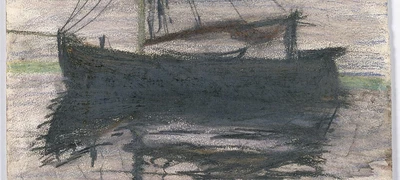Paula Modersohn-Becker and the Worpsweders. Drawings and Prints. 1895-1906

“One needn’t think so much about nature when painting (. . .) my own perception is the main thing.” Diary entry of 1.10.1902 It was the young painter Paula Modersohn-Becker who wrote these sentences. This short quotation alone makes it clear that Modersohn-Becker (1876–1907) was among those painters who, around the turn of the century, stood clearly in opposition to the strict dictates of academic style. She did not want to paint in studios, but in the open air, and this is why she moved to the Worpswede artists’ colony. But unlike her colleagues Otto Modersohn, Hans am Ende, Fritz Mackensen, Fritz Overbeck, and Heinrich Vogeler, Modersohn-Becker did not see her role models in impressionism and art nouveau, but in the works of Cézanne, van Gogh, and Gauguin. They encouraged her in her own rejection of the depiction of external appearances and her search for a deeper essence. The simplification of artistic form that this entailed is very evident in her drawings, which are often more radical in this respect than her paintings. For this reason, this Institut für Auslandsbeziehungen exhibition focuses on Modersohn-Becker’s drawings and etchings, complemented by works by her fellow Worpswede artists.
78 Stops
Samarkand, Uzbekistan
Art Station gallery by Silk Road University
2025
20.06.–27.11.
Brașov, Romania
Universität Transilvania Brașov
2024
01.06.–12.07.
Timișoara, Romania
Muzeul de Artă Timișoara
2024
20.03.–21.04.
13 Artists
3 Contributors
Wulf Herzogenrath,
Karin Lisewski (ifa),
Concept
Alexander Lisewski,
Project Management ifa
About the exhibiton
Today, the artistic colony of Worpswede has lost none of its fascination, attraction, and charisma.
Lev Kopelev can certainly be seen as a very special witness of his times, as a writer and campaigner for human rights, and as one of the leading advocates of a strong united Europe. This “Jewish Russian,” born in 1912 in Kyiv, who later became a friend of Heinrich Böll, his former enemy in wartime, loved to visit Worpswede—and later also the Kunsthalle Bremen. In the mid-1990s, during one of his visits to Worpswede, he explained his fascination for the artists’ colony. Kopelev admired the fact that all these artists and friends lived in this small village, with their contrasting views of society, either simultaneously or one after the other. There was the far-left leaning Heinrich Vogeler, a member of the Bremen Workers’ and Soldiers Council in 1918, and the far-right leaning Fritz Mackensen, who enlisted for a year at a Nazi art academy in 1933. Both of these men, with their so different approaches to life, came to a sorry end. Mackensen died in poverty, and Vogeler in a forlorn far-away village in Kazakhstan.
Wulf Herzogenrath